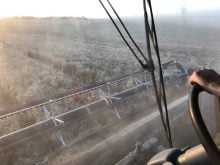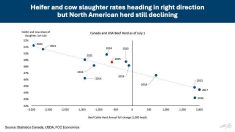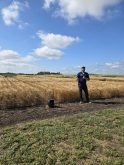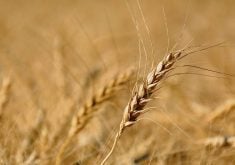The grading threshold will change this summer regarding severity of sprouted wheat.
On June 13, the Canadian Grain Commission announced changes, effective Aug. 1, for how Canadian wheat is graded. It also issued a list of clarifications and new housekeeping rules for the grading of other crops it regulates.
They include a shift in how “severely sprouted” is defined under its Official Grade Guide for western wheat classes.
Read Also

The sneak peak of Manitoba Ag Days 2026
Canada’s largest indoor farm show, Manitoba Ag Days, returns to Brandon’s Keystone Centre Jan. 20-22, 2026. Here’s what to expect this year.
Why it matters: Research showed that certain seeds now relegated to the “severely sprouted” grade had end-use quality that matched better with “regular sprouted” wheat.
The changes follow a laboratory review on the end-use quality of sprouted wheat.
Starting Aug. 1, kernels of sprouted western wheats with sprouts broken or missing (but without any clear evidence of a sprout’s length or severity) will be redefined as “regular sprouted” rather than “severely sprouted.”
Currently, a kernel of wheat is classified as “regular sprouted” if sprouts are visible but still “within the contours of the germ.”
To be classified as “severely sprouted,” a kernel today must either be “severely degenerated”—clearly sprouted beyond the contour of the germ — or it must show signs of a sprout that’s broken or missing, whether with or without clear evidence of length or severity.
The historic argument has been that a kernel deemed “severely sprouted” contains a higher level of alpha-amylase than a “regular sprouted” kernel. This has negative impacts on the wheat’s falling number, which in turn is an indicator of grain soundness.
But research done last year and this year at the CGC’s Grain Research Laboratory calls that into question.
Researchers found kernels of Canada Western Red Spring (CWRS) and durum wheats that showed a sprout broken or missing, without clear evidence of the sprout’s length or severity, showed the same range of alpha-amylase activity and impact on falling number as “regular sprouted” wheat.
The impact on end-use functionality, the lab found, was “similar to that of regular sprouted kernels.”
The Manitoba Crop Alliance, which represents wheat growers in the province, declined to comment on the changes.
Tolerances
Among other changes scheduled to take effect Aug. 1, tolerances for test weight and total foreign material are being matched in most classes of western wheat that, until now, had different tolerances for “primary” or “export” use.
Under the new rule, test weight and total foreign material tolerances will be aligned to the “export” tolerances for all grades of:
- Canada Western Red Spring (CWRS),
- Canada Western Hard White Spring (CWHWS),
- Canada Western Extra Strong (CWES),
- Canada Western Soft White Spring (CWSWS), and
- Canada Northern Hard Red (CNHR) wheats.
Total foreign material “primary” and “export” tolerances for Canada Western Amber Durum (CWAD) wheat will also be lined up to the “export” tolerances for all grades.
An “export” tolerance is used when grain is destined for an overseas market and is shipped out of the country through a terminal grain elevator. Such a tolerance is set based on research and is used to ensure milling quality expectations are met, the CGC said.
A “primary” tolerance is set lower than an “export” tolerance. It’s used when grain is delivered directly to a primary grain elevator within Canada.
Sieves
Other updates to the Official Grade Guide will appear in the canola chapter, in the process for determining dockage. The change will clarify the process and the different-sized sieves that should be used.
That change, the CGC said, comes in the wake of concerns raised by producers about “inconsistencies in the process used at delivery.”
The guide’s definition of “processed sample” will be updated in all chapters, in the wake of issues where samples were submitted to the CGC for official grades with dockage already removed.
The guide will also adjust the composition of dockage to include insect parts, and the definition for insect parts will be adjusted in the lentil, bean, chickpea and faba bean chapters.
Also, in the canary seed chapter, the composition of dockage will be adjusted to include the percentage of hulled seeds in dockage, and the definition of foreign material and hulled seeds will be adjusted accordingly.
















